Stand with your feet as wide as your shoulders with your hands on your hips. Tip straight to the side. Let your head tip in the same direction. Hold for a count for fifteen and repeat to the opposite side. Do three sets alternating the sides. Repeat the same motion but straighten the arm on the side you are stretching and reach above your head as you bend. Again hold for a count of fifteen and do three to each side.


Raise your arms out to the side to stabilize your spine. Bend one knee and cross that leg over the other leg letting it drop towards the bed or floor. Counter rotate your head in the opposite direction. Hold for a count of fifteen and repeat to the opposite side. Do three sets alternating the sides.
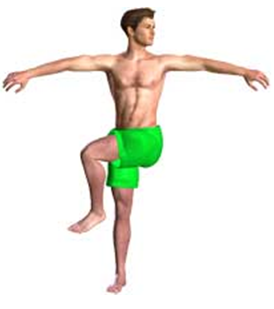
Lie on your stomach, with your forearms under you. Press down and raise your upper back without letting your pelvis rise. Relax your stomach muscles by taking a deep breath and let your back to arch. Do not contract your back muscles. Hold this position with your breath out and slowly return to the floor. Inhale and repeat 5 times.
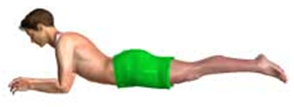
Stand with your hands on your hips. Take a deep breath and slowly lean back while keeping your neck straight. Try not to bend your knees. Hold for 5 seconds and return to a standing position. Repeat this 5 times.
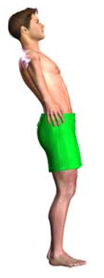
Get on your hands and knees on the floor. Tighten your stomach muscles by blowing all of your air out. Bring one leg up straight behind you and hold it in this position. Be careful not to rotate your pelvis. Start by holding this position for 5 seconds and as you gain strength, lengthen the time. Repeat this position with the opposite leg. As you further gain strength, raise the opposite arm in front of you and hold while raising your leg.
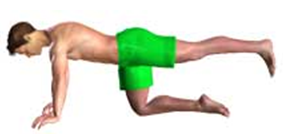
Basically, the alkaline diet is opposite the high protein, high fat, low carb diets that are currently in vogue. Most people have never heard of alkaline-acid balance, but many holistic doctors and nutritionists consider a properly balanced diet to be important to optimal health and preventing diseases such as cancer. The theory behind an alkaline diet is that because our body’s pH level is slightly alkaline, with a normal range of 7.36 to 7.44, our diet should reflect this and also be slightly alkaline. An imbalanced diet high in acidic foods such as animal protein, sugar, caffeine, and processed foods tends to disrupt this balance. It can deplete the body of alkaline minerals such as sodium, potassium, magnesium, and calcium, making people prone to chronic and degenerative disease. Thorough scientific studies are lacking on the alkaline diet. Many conventional doctors do not believe in the alkaline diet. Who is this diet for? Try this diet if you feel unwell on a high fat, low carb diet. It may also aid people who lead stressful lives and or those who consume large amounts of acidifying foods such as protein, sugar, processed food, cereals, starches, and caffeine, with little alkalinizing vegetables. What are the symptoms of excess acidity?
- Low energy, chronic fatigue
- Excess mucous production
- Nasal congestion
- Frequent colds, flues, and infections
- Nervous, stressed, irritable, anxious, agitated
- Weak nails, dry hair, dry skin
- Formation of cysts, such as ovarian cysts, polycystic ovaries, benign breast cysts (fibrocystic breasts)
- Headaches
- Joint pain or arthritis
- Neuritis
- Muscle pain
- Hives
- Leg cramps and spasms
- Gastritis, acid indigestion
Medical doctors try to test the acidity or alkalinity of the body tissues and cells by analyzing the blood. Harold Hawkins, developed methods to measure urine pH and other factors such as saliva pH. Modern proponents of the alkaline diet look at the pH of blood, saliva, and urine, in addition to health symptoms and other factors. What are the guidelines of this diet? An alkaline diet is composed of approximately 75% alkaline foods and 25% acid foods. The foods listed below are in descending order of alkalinity and acidity.
- Alkaline Foods — 75% of diet
- Vegetables — Sea vegetables, burdock, lentils, onion, taro, sweet potato, kohlrabi, parsnip, garlic, kale, endive, mustard greens, ginger root, broccoli, potato, bell pepper, mushrooms, cauliflower, eggplant, pumpkin, collard greens, Brussels sprouts, chives, cilantro, okra, squash, lettuce
- Fruit — Limes, nectarines, persimmons, raspberries, watermelon, tangerines, grapefruit, cantaloupe, honeydew, citrus, olives, loganberries, mango, lemons, pears, avocado, pineapple, apples, blackberries, cherries, peaches, papaya, oranges, apricots, bananas, blueberries, currants, raisins, grapes, strawberries
- Nuts, seeds, oils — Pumpkin seeds, poppy seeds, chestnuts, pepper, primrose oil, sesame seeds, almonds, sprouts, avocado oil, flaxseed oil, coconut oil, olive oil, other seeds
- Grains — Oats, grain coffee, quinoa, wild rice
- Condiments — Baking soda, sea salt, mineral water, spices, cinnamon, molasses, soy sauce, herbs, green tea, rice syrup, apple cider vinegar, ginger tea, ghee
- Dairy — Buttermilk, cheeses and yoghurt.
- Acidifying Foods — 25% of diet
- Dairy — Processed cheese, ice cream, soymilk, cow’s milk, aged cheese, soy cheese, cream
- Animal meat — All meat, poultry, eggs, and seafood. Beef, pheasant, pork, veal, squid, lobster, chicken, lamb, boar, shellfish, goose, turkey, eggs, gelatin, organs, venison, duck
- Grains — All foods made from cereal grains including breads, breakfast cereals, crackers, pasta and rice. Barley, barley, corn, rye, oat bran, buckwheat, wheat, spelt, semolina, white rice, millet, kasha, amaranth, brown rice. Avoid all refined flour products such as white bread, pasta, cakes, pies, cookies.
- Legumes — Legumes including beans, peas, lentils and peanuts.
- Nuts, seeds — All nuts. Hazelnuts, walnuts, Brazil nuts, pistachio seeds, pecans, palm kernel oil, almond oil, sesame oil, safflower oil, pumpkinseed oil, grapeseed oil, sunflower oil, pine nuts, canola oil
- Vegetables — Soybeans, carob, green peas, peanuts, snow peas, carrots, chickpeas, tofu, pinto beans, white or red beans, azuki beans, lima beans, kidney beans, string beans, rhubarb
- Fruit — Fruits containing benzoic or oxalic acid including prunes, plums, cranberries, rhubarb and sour cherries.
- Condiments — Jam, jelly, table salt, yeast, sugar, chocolate, cocoa, white vinegar, nutmeg, coffee, saccharin, vanilla, black tea, alcohol, balsamic vinegar, curry, honey, maple syrup, rice vinegar. Also avoid chocolate milk, sodas, wine, alcohol.
Sleep requirements change as we age. When we are infants, we spend most of time asleep. We eat, sleep, fill our diapers, look around and then fall back to sleep.
We need more sleep between puberty and age 25 than any other time of our lives except when we are infants. Experts, at Cornell University, say we need about 9 hours of sleep during these years. The average is 6 hours and 54 minutes – two hours short of what we really need.
During your 20’s, try and get to bed by 9:30. An alternative that is better than nothing is to skip nights. Stay up later one night and then go to bed earlier the next. This stops the sleep depravation from adding up day after day.
Our internal clock goes into sleep mode around 11 PM. This is when melatonin production is elevated. If you have difficulty falling asleep, take very small dose of melatonin may help you fall asleep faster. Don’t try and make up for the lack of sleep on the weekends. Get up at your normal time, and if you need to, take a power nap around noon.
In your thirties, stress becomes one of the culprits of too little sleep. One of the main reasons is elevated cortisol levels that are a result of stress in your life. Ron Klatz, M.D. recommends taking B5 – pantothenic acid, before going to bed to help reduce the levels of cortisol. Ironically, aspirin may also reduce cortisol levels. Elevated levels of cortisol prevent you from reaching the deep sleep that you really need. An alternative technique is to go for a brisk short walk late in the afternoon. Researchers at the university of Arizona found that this causes your body temperature to drop in the evening and helps you get into a deep sleep pattern.
By the time you reach your 50’s sleep problems are rampant. Cortisol levels, due to stress in our lives, are up to 12 times higher than when we are in our thirties. Approximately 1 out of 25 people have sleep apnea.
Again, pantothenic acid taken before bed with fruit juice for its sugar, fructose, will help reduce that elevated cortisol. Many medications, especially beta-blockers cause a reduction in melatonin levels. A study published in the European journal of Pharmacology, showed that the reduction was in the order of 80 – 90 percent. Prozac is another medication that will reduce melatonin levels.
The following exercises have been shown to increase muscle coordination. They are helpful in programming the muscles of the extremities to fire in their normal pattern. Each should be done ten times. All exercises start with you standing evenly on both feet.
Cross Crawl: Starting Position / Overview

Turn your head to the left when your left arm moves. Turn your head to the right when your right arm moves.
Exercise 1: Anterior cross crawl
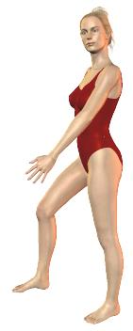
Bring forward the opposite arm and leg. Return them to the starting position and then repeat with the opposite arm and leg. Remember to turn your head to the side as shown above.
Exercise 2: Posterior cross crawl
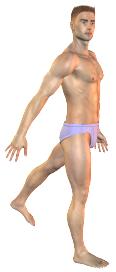
Bring the opposite arm and leg back behind you. Return them to the starting position and then repeat with the opposite arm and leg. Remember to turn your head to the side as shown above.
Exercise 3: Side to side cross crawl
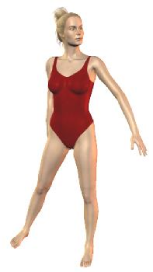
Above you will see the opposite arm and leg are taken out to the side. Return them to the starting position and then repeat with the opposite arm and leg. Remember to turn your head to the side indicated and return it to a straight forward position during the opposite arm leg combination.
It has been estimated that at least 15 – 20% of the population is gluten intolerant. Some studies from England have shown that 35% of the people tested had a digestive enzyme defect that caused gluten and casein, a milk protein, to be digested improperly causing gastrointestinal and systemic symptoms. Gluten is a composite protein formed from several different proteins. It is found most commonly in wheat and other related grains, such as barley and rye. Adding texture and a characteristic chewiness to baked goods, this ingredient is used in a wide variety of other foods as a thickener and binder, flavor enhancer, and protein supplement. Severe gluten intolerance can cause celiac disease. This is an immune reaction with sudden severe symptoms of abdominal pain and diarrhea. It also causes malabsorption of nutrients causing malnutrition. Gluten intolerance has a slow onset and causes a wide variety of symptoms. There are many potential causes of gluten intolerance. It has been found that emotional stress, surgery, and pregnancy can severely aggravate and make worse these two conditions. Infants who are breast fed longer also have a decreased history of these diseases. The theory is that foods with high gluten content are not introduced when the infant’s digestive tract has not developed enough to properly digest the gluten.
Possible symptoms of celiac or gluten intolerance:
- Weight loss or weight gain
- Nutritional deficiencies due to malabsorption e.g. low iron levels
- Gastro-intestinal problems (bloating, pain, gas, constipation, diarrhea)
- Fat in the stools (due to poor digestion)
- Aching joints
- Depression
- Eczema
- Headaches
- Exhaustion
- Irritability and behavioral changes
- Infertility, irregular menstrual cycle and miscarriage
- Cramps, tingling and numbness
- Slow infant and child growth
- Decline in dental health
If the condition is undiagnosed for long periods of time, food intolerances have been found to contribute to diabetes, bowel cancer, anemia and osteoporosis.
What to avoid:
- Barley (malt, malt flavoring and malt vinegar)
- Rye
- Triticale (a cross between wheat and rye)
- Wheat
- Bulgur
- Durum flour
- Farina
- Graham flour
- Kamut
- Semolina
- Spelt
Other foods that have to be labeled as “gluten free” as they can be made with gluten:
- Beer
- Breads
- Cakes and pies
- Candies
- Cereals
- Cookies and crackers
- Croutons
- French fries
- Gravies
- Imitation meat or seafood
- Matzo
- Pastas
- Processed luncheon meats
- Salad dressings
- Sauces, including soy sauce
- Seasoned rice mixes
- Self-basting poultry
- Seasoned snack foods, such as potato and tortilla chips
- Soups and soup bases
- Vegetables in sauce
Overlooked items that can contain gluten: Food additives, such as malt flavoring, modified food starch and medications and vitamins that use gluten as a binding agent.
Common problems with a gluten free diet: There are some vital nutrients that we usually get from foods that contain gluten. Eating a diet without these gluten containing foods can lead to deficiencies in the following nutrients:
- Iron
- Calcium
- Fiber
- Thiamin
- Riboflavin
- Niacin
- Folate (folic acid)

The most common injuries seen in the office are those that are due to straining of muscles, ligaments and tendons. As a group, these structures are known as connective tissue. When an injury occurs, the first stage of healing is called the reaction phase. This stage can last for up to 7 days. The length of time depends on the extent of the injury and what you do to speed the healing process. In this first stage of healing, you will have an increase in circulation near the site of the injury. Along with this there will be swelling or edema, which is caused by the cells that have been broken during the injury. The first goal is to try and limit the amount of swelling that occurs. When there is too much swelling more cells become damaged and more swelling occurs. This sets up a vicious cycle of swelling – damaged cells – more swelling – more damage. To limit the degree of damage, we usually recommend RICE. RICE is not something you eat but stands for Rest Ice Compression and Elevation.
You want to REST the area that is injured. Continued activity will cause more damage to the injured structures and consequently more swelling and tearing of cells.
ICE, in the form of cold packs, will cause local contraction of blood vessels and reduce pain. A good starting point is to use ice for 20 minutes every hour immediately after an injury for four to five hours. The effects of the ice will last for 15 – 30 minutes and will be gone within an hour. For three days after the injury, continue using the ice 3 – 4 times a day. If you have Raynauds, hives from contact with ice, diabetes, or any vascular disease do not put ice on your skin. Instead, place a cold cloth over the area of injury and call us for additional help.
The letter C stands for COMPRESSION. Wrapping the area of injury with an elastic wrap will help to limit the amount of swelling. For example, if you have turned your ankle and it is starting to swell, put an ice pack around the ankle and wrap up the ankle and lower leg with an elastic bandage. This will help to limit the swelling and allow us to do a better job of speeding your recovery when we examine and treat the injury.
Finally, the E stands for ELEVATION. If it is possible, raise the injured part above the level of your body. If you injured your ankle, raise your leg above your pelvis. If you injured your wrist, support your arm above the height of your shoulder. This allows gravity to help remove the swelling.
During the injury, the breaking of blood vessels initiates several chain reactions. A clot is formed from proteolytic enzymes released by cells called platelets. Your body creates creates a clot or mesh where the vessels have become broken. The lymphatics, the sewer of our vascular system, become blocked with these clots. The cells release substances known as bradykinins, which cause pain, and are released due to the injury. These cause vasodilation, expansion of the arteries, and increased permeability and increased swelling . Other factors are released locally to breakdown severely damaged tissue and prevent infection.
During this phase of injury it is important to limit the inflammation. Some inflammation is essential and unavoidable. Too much inflammation causes more swelling and injury.
Controlling this inflammation and speeding recovery depends on more than just taking an anti-inflammatory drug. Your body uses enzymes to help clear up damaged tissue and speed the recovery. A good example is a multi car accident on a large highway. The traffic will get backed up for miles on the side of the accident and on the other side with people looking at the accident. Due to the damage done, your body attempts to block off damaged vessels so that more blood doesn’t escape. Getting the wrecked cars off the road is one of the first things that have to be done to get the roadway open. Enzymes accomplish this. Your body makes some, but taking more of them speeds up the removal of the damaged tissue and reestablishes the normal blood flow to and from the injury site. To summarize, the primary goal after an injury is to limit the amount of injured tissue. To do this, remember the acronym RICE.
- Rest – stop moving the injured area
- Ice – apply cold packs of ice
- Compression – wrap up the area if possible
- Elevation – elevate the injured area if you can
Call your local AK office and we will examine the injured structures to see the extent of the injury. Depending on what is found, we may suggest nutritionally supporting your own production of anti-inflammatories, or taking enzymes to speed the healing process. If they are indicated, studies have shown that healing times can be reduced up to 50% with similar reductions in pain and swelling when enzymes are taken after an injury. The only problem is that they must be started as soon as possible. This is not a time to wait and see if you feel better in a few days, as the window for starting the treatment is very short.
After the Reaction stage, there are two other stages that traumatic injures go through. These are called regeneration and remodeling.
In the regeneration stage, your body builds new capillaries to replace the damaged ones. This process is known as angiogenesis. At the same time, your body starts to rebuild the damaged connective tissue. It does this by making collagen strands. Collagen is made up of amino acids. Amino acids are the small subunits of protein. Consequently, your diet must contain enough protein to help you make these collagen strands.
If you look at a forest, all of the trees are parallel with each other. Once in a while you will see a tree that has fallen down and caught in another tree. Collagen fibers are similar to this. Collagen is supposed to be in parallel lines. After an injury, your body makes a mesh with collagen fibers going in all directions. Another example is the kids game Pick up Sticks. All of the collagen fibers should be parallel, but after an injury they look like the sticks when they are dropped. The fibers are running in all directions. In order to make a strong bond at the site of the injury, this crossing of fibers – or cross-links – are necessary. One problem is that these cross-links limit the range of motion of the structures that have been injured. You may not be able to move your arm or ankle as freely as you once did. In the last stage of healing, remodeling, the cross-links are slowly reduced and range of motion is increased.
In the regeneration stage, we want to continue to minimize any swelling and inflammation and stimulate protein production of the collagen bonds. Controlled motion helps to unsure that most of the collagen will be laid down in the lines of the normal joint action. Dietary modification to insure adequate protein intake is very important as is limiting foods and substances that encourage the inflammatory process. This would include an excess of animal fats, alcohol and partially hydrogenated fats. Increasing omega 3 oils like EPA or eating deep-water fish will help to limit any inflammation. To insure adequate protein intake, small servings of protein should be consumed throughout the day. In the office, our goal is to make sure that the muscles that have been damaged are treated and made functional. Ligaments that have been damaged may need support both structurally and nutritionally. Keeping the joints aligned properly will allow the damaged structures to heal back to their normal lengths. This stage of the healing goes from 48 hours after the injury in a mild case to over 8 weeks in a more severe injury.
In the remodeling stage, the cross links that were formed in the regeneration stage are slowly reduced and the range of motion is increased. In this phase, care is taken to reestablish the motion of the joint. This may require massage type work or stretching. Much of this is done in normal daily living, but the problem is that we tend to protect the injured part by not using it and thereby limit the return to full function. The other major goal in this phase of the healing is to reestablish normal proprioception. This involves muscle coordination. Muscles react to each other. The contraction of one muscle causes an opposing muscle to relax. When a muscle contracts it should not cause another muscle to weaken when it should be helping the contracting muscle. When this ballet of muscle coordination is not functioning properly, ache and pain will be caused when you use the injured part or you will have a decreased range of motion. In the office, we need to test the muscles doing various tasks to determine that the coordination is working properly. In simple injuries, this remodeling stage will begin as early as the fourteenth day after the injury. In severe injuries, the stage may last well over 1 year.
Only when full range of motion and coordinated muscle function has been attained have you recovered from an injury. If these goals are not attained, permanent decreased function and compensations by your body will lead to other problems.
An example is someone who has injured his or her ankle and it doesn’t fully recover. They will walk with a slight limp that will cause knee and hip problems. Year’s later, arthritis in the ankle, knee and hip joints may result due to the changes that have occurred.
Restoration of normal function depends on successfully completing the three stages of healing. Each one has its own goals and requirements.
The glycemic index is a ranking of carbohydrate foods based on their immediate effect on blood sugar levels. Carbohydrates that breakdown quickly during digestion have the highest glycemic indexes. The blood glucose response is fast and high. Carbohydrates that breakdown slowly, releasing glucose gradually into the blood stream and have low glycemic indexes.
When you eat a slice of bread, the flour from the bread breaks down into sugar. The same thing happens when you eat a piece of fruit, drink a glass of milk or eat a chocolate bar. Each of these foods contains a different kind of sugar. Fructose is a sugar in fruit, lactose is found in milk and sucrose is found in a candy bar. All of these sugars are broken down during digestion and provide you with energy.
The speed at which a food is able to increase a person’s blood glucose levels is the glycemic response. The glycemic response is influenced by many factors. Some factors may be the amount of food you eat, how the food is processed or the way the food is prepared. For example, pasta cooked ‘al dente’ (firm) is absorbed more slowly than pasta that is overcooked.
You can make this very difficult or simplify it. Simply, eating more low glycemic foods instead of high glycemic foods will have positive changes in your life.
What are the consequences of low GI foods?
- A smaller rise in blood glucose levels after meals
- Help people in weight loss
- Improve the body’s sensitivity to insulin
- Help re-fuel carbohydrate stores after exercise
- Improved control of diabetes
- Keep you fuller for longer after eating
- Prolong your physical endurance
Basics of a low GI Diet
- Use breakfast cereals based on oats, barley and bran
- Use “grainy” breads made with whole seeds
- Reduce the amount of potatoes you eat
- Enjoy all types of fruit and vegetables (except potatoes)
- Eat plenty of salad vegetables with vinaigrette dressing
- Reduce simple sugars – man-made products from your diet
- Limit fruit juice in your diet
These values are just guides to help you make choices between foods. Talk to your local AK doctor or a nutritionist about how to apply these guides to your daily life.
| Cereals | |
| All Bran | 51 |
| Bran Buds | 45 |
| Bran Flake | 74 |
| Cheerios | 74 |
| Corn Chex | 83 |
| Cornflakes | 83 |
| Cream of Wheat | 66 |
| Frost Flakes | 55 |
| Grape-Nuts | 67 |
| Life | 66 |
| Muesli | 54 |
| Nutri-Gran | 66 |
| oatmeal | 48 |
| Puffed Wheat | 67 |
| Raisin Bran | 73 |
| Rice Chex | 89 |
| Shredded Wheat | 67 |
| Special K | 54 |
| Total | 76 |
| Fruit | |
| apple | 38 |
| apricots | 57 |
| banana | 56 |
| cantaloupe | 65 |
| cherries | 22 |
| dates | 103 |
| grapefruit | 25 |
| grapes | 46 |
| kiwi | 52 |
| mango | 55 |
| orange | 43 |
| papaya | 58 |
| peach | 42 |
| pear | 58 |
| pineapple | 66 |
| plums | 39 |
| prunes | 15 |
| raisins | 64 |
| watermelon | 72 |
| Snacks | |
| chocolate bar | 49 |
| corn chips | 72 |
| croissant | 67 |
| doughnut | 76 |
| graham crackers | 74 |
| jelly beans | 80 |
| Life Savers | 70 |
| oatmeal cookie | 57 |
| pizza, plain | 60 |
| Pizza Hut, supr | 33 |
| popcorn light | 55 |
| potato chips | 56 |
| pound cake | 54 |
| power bars | 58 |
| pretzels | 83 |
| Saltine Cracker | 74 |
| shortbread, cookie | 64 |
| Snickers bar | 41 |
| strawberry jam | 51 |
| vanilla wafers | 77 |
| Wheat Thins | 67 |
| Crackers | |
| graham | 74 |
| rice cakes | 80 |
| rye | 68 |
| soda | 72 |
| Wheat Thin | 67 |
| Cereal Grains | |
| barley | 25 |
| basmati rice | 58 |
| bulgur | 48 |
| couscous | 65 |
| cornmeal | 68 |
| millet | 71 |
| Sugars | |
| fructose | 22 |
| honey | 62 |
| maltose | 105 |
| table sugar | 64 |
| Pasta | |
| cheese tortellini | 50 |
| fettuccini | 32 |
| linguini | 50 |
| macaroni | 46 |
| spagh, 5min | 33 |
| spagh, 15min | 44 |
| spagh, prot enr | 28 |
| vermicelli | 35 |
| Soups/Vegetables | |
| beets, canned | 64 |
| black bean soup | 64 |
| carrots, boil | 49 |
| corn, sweet | 56 |
| green pea soup | 66 |
| green pea, frozen | 47 |
| lima beans, frozen | 32 |
| parsnips | 97 |
| peas, boiled | 48 |
| split pea soup | 66 |
| tomato soup | 38 |
| Drinks | |
| apple juice | 40 |
| colas | 65 |
| Gatorade | 78 |
| grapefruit | 48 |
| orange juice | 46 |
| pineapple juice | 46 |
| Milk Products | |
| chocolate milk | 35 |
| custard | 43 |
| ice cream, van | 60 |
| ice milk, van | 50 |
| skim milk | 32 |
| soy milk | 31 |
| tofu frozen dessert | 115 |
| whole milk | 30 |
| yogurt, fruit | 36 |
| yogurt, plain | 14 |
| Beans | |
| baked | 44 |
| black, boiled | 30 |
| butter, boiled | 33 |
| cannelloni beans | 31 |
| garbanzo, boiled | 34 |
| kidney, boiled | 29 |
| kidney, canned | 52 |
| lentils | 30 |
| lima, boiled | 32 |
| navy beans | 38 |
| pinto, boiled | 39 |
| red lentils, boiled | 27 |
| soy, boiled | 16 |
| Breads | |
| bagel, plain | 72 |
| baquette, french | 95 |
| croissant | 67 |
| dark rye | 76 |
| hamburger bun | 61 |
| Muffins | |
| apple, cin | 44 |
| blueberry | 59 |
| Breads | |
| pita | 57 |
| pizza, cheese | 60 |
| pumpernickel | 49 |
| sourdough | 54 |
| rye | 64 |
| white | 70 |
| wheat | 68 |
| Root Crops | |
| french fries | 75 |
| pot, new, boiled | 59 |
| pot, red, baked | 93 |
| pot, sweet | 52 |
| pot, white, boiled | 63 |
| pot, white, mash | 70 |
| yam | 54 |
Low GI = 55 or less Medium GI = 56-69 High GI = 70 or more
The following stretches should be done morning and night. These are designed to reduce tension in the upper back. Do not force any of these.
Back Side To Side
Place your hands on your hips with your feet about as wide as your shoulders. Bend to each side while moving your eyes to the side that you are bending. Let the arm on the side that you are bending over slide down along your leg. Hold for a count of fifteen and repeat to the opposite side. Repeat this three times.
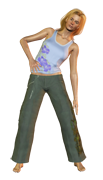



Side Bend Reaching
For this exercise, stand with your feet apart and your arms straight to the side. Bend over and twist reaching towards the opposite knee or foot. Hold for a count of fifteen and repeat to the opposite side. Repeat this three times.
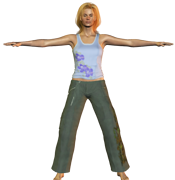

Sitting Stretches
Sit and cross your arms holing on to the opposite shoulder. First twist as far as you are comfortable. Hold this for a count of 15 and then repeat to the opposite side. Repeat this three times each. Next, bend and twist while you exhale. Hold this for a count of 15 and repeat to the opposite side. Repeat this 3 times to each side. Finally, bend forward as far as you can while blowing your breath all the way out. Let your arms hang between your legs. Hold this for a count of 15 and repeat 3 times.


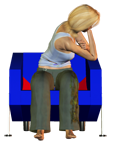
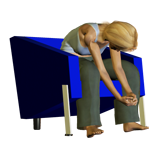
Upper Chest Stretch
Lie on your back and place a pillow under the middle of your abdomen Take both arms and raise them so that your hands are above your head. As your chest loosens, you can hold a light object in your hands and this will increae the stretch. This is best done lying on a bed and letting your arms hang over the side. Inhale as much air as you can and hold it for a count of 5 and then let your breath out as far as you can and again hold this for a count of 5. Repeat this 10 times.
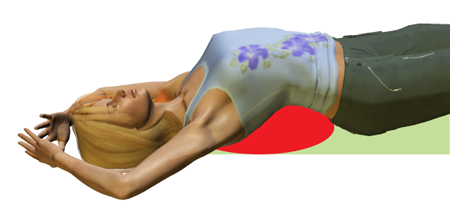
In order to increase the range of motion in your neck, you need to stretch your neck through a full range of motion. These stretches will help to normalize the lengths of the muscles and potentially help to increase the fluid in the discs. In order to achieve good results, do the following exercises at least twice a day.
- Flexion. Sit nice and straight, take a deep breath in and bring your chin towards your chest as you inhale. Inhale as deeply as possible and bring your head as far forward as you can, then slowly exhale and come back to the neutral position.

- Extension. Inhale deeply and tilt your head backwards as far as you can comfortably while you are inhaling as deeply as possible, then slowly exhale and bring your head back to the full upright position.
- Series of Four. The next four steps will bring your head through an X range of motion. Imagine yourself looking at the top of your head from above, and the figure you will create is an X shape. The first range of motion will have you stretch the muscles in the back left side of your neck, and this will be done by having you inhale and bend your head forward and to the right at a 45 degree angle. This is done precisely as the previous exercises, having you inhale while you go through the range of motion to the full extent and then exhale when you go back to neutral.
- For the first series of four you will inhale and bend as far forward to the right as possible at a 45-degree angle, and then exhale and come up to neutral.
- For the second step you will inhale and extend your head back and to the left at a 45-degree angle, inhaling down, exhaling up.
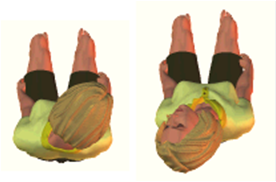
-
- For the third step you will inhale and breathe, bending your head forward and to the left at a 45-degree angle, coming back to neutral as you exhale.
- For the final step you will inhale and bend backwards and to the right at a 45-degree angle.

- Lateral Bending. Sitting nice and straight inhale and bring your right ear towards your right shoulder, exhale and relax your shoulders, return to neutral, repeat on the left side.
- Rotation. Inhale and look as far as you can to your left over your left shoulder, exhale and come back to center. Then inhale and repeat on the right.

The following is a collection of stretches, exercises, and information that you can readily use in your efforts to be healthy.